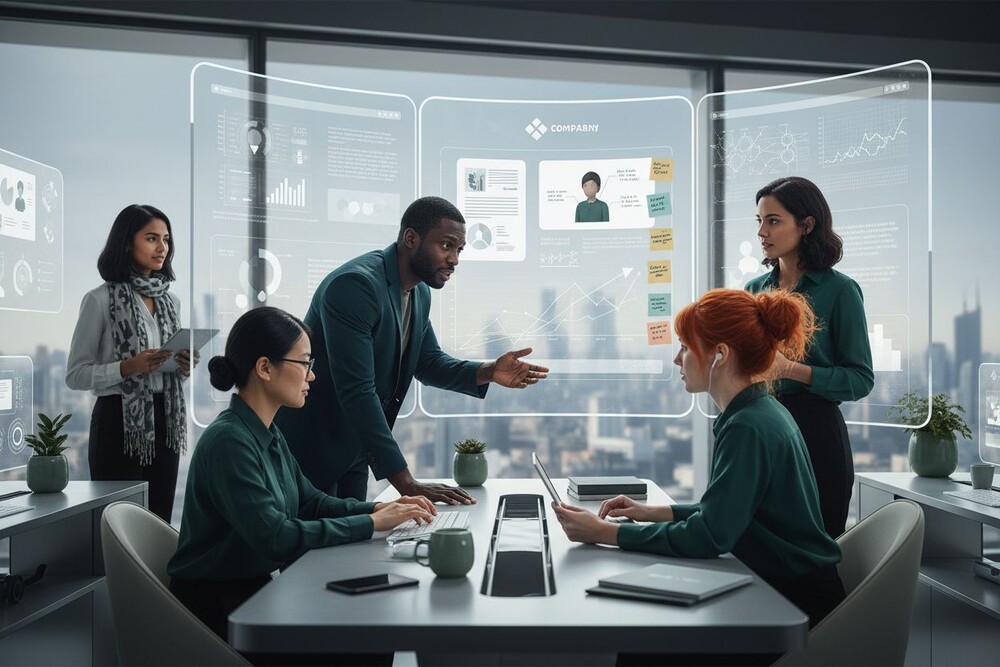Table of Contents
- Defining Virtual Team Building Trends 2025
- Emerging Formats And Activity Types
- Key Technologies Shaping Virtual Collaboration
- Global Best Practices For Engagement And Inclusion
- Common Pitfalls And How To Avoid Them
Key Takeaways
| Point | Details |
|---|---|
| Emerging Digital Tools | Advanced digital collaboration tools and AI will reshape virtual team interactions in 2025. |
| Diverse Activity Formats | Innovative formats such as gaming experiences and wellness sessions are essential for team engagement. |
| Strategic Communication | Clear communication frameworks and inclusive practices are critical for effective global virtual collaboration. |
| Addressing Pitfalls | Proactive management of potential challenges like communication silos and digital fatigue is necessary for team cohesion. |
Defining Virtual Team Building Trends 2025
Virtual team building is rapidly transforming how organizations collaborate, driven by technological advancements and changing workplace dynamics. According to the OECD’s Trends Shaping Education 2025 report, technological innovations are fundamentally reshaping team interactions across global platforms.
Key trends emerging in virtual team building for 2025 include enhanced digital collaboration tools, immersive remote experiences, and strategic approaches to maintaining team connectivity. Research from the CIPD’s evidence review highlights the critical need for organizations to develop sophisticated strategies that support effective virtual team performance.
The most significant developments center around several core areas:
- Interactive Digital Platforms: Advanced tools enabling real-time collaboration
- Gamification of Team Activities: Engaging remote employees through interactive experiences
- Psychological Connection Technologies: Tools designed to build emotional rapport across digital spaces
- AI-Enhanced Team Dynamics: Intelligent systems that analyze and improve team interactions
These emerging trends demonstrate that virtual team building is no longer just about technology—it’s about creating meaningful human connections in an increasingly digital workspace. Learn more about virtual team building strategies in our comprehensive guide.
Emerging Formats and Activity Types
Virtual team building has evolved dramatically, with innovative formats transforming how remote teams connect and engage. Oreed’s research reveals an expansive landscape of 80 distinct online team-building activities designed to bridge digital distances and create meaningful interactions.
Collaborative Digital Experiences have become the cornerstone of modern virtual team engagement. According to EHL Hospitality Insights, creative approaches like virtual book clubs, remote team dinners, and even virtual dance parties are gaining significant traction as powerful team bonding mechanisms.
- Interactive Gaming Experiences: Multiplayer online challenges that promote strategic thinking
- Creative Collaboration Workshops: Digital spaces for collective problem-solving
- Simulation-Based Activities: Immersive scenarios mimicking real-world business challenges
- Cultural Exchange Programs: Virtual sessions exploring team members’ diverse backgrounds
- Wellness and Mindfulness Sessions: Digital platforms promoting mental health and collective relaxation
Explore our interactive team building tools to discover how technology can transform remote team dynamics into engaging, memorable experiences.
Key Technologies Shaping Virtual Collaboration
The landscape of virtual collaboration is being dramatically reshaped by cutting-edge technologies that transcend traditional communication barriers. According to the OECD report, emerging technologies like the Internet of Things (IoT) and artificial intelligence are revolutionizing how teams interact and collaborate across digital platforms.
Advanced Communication Technologies are emerging as the backbone of effective virtual teamwork. The CIPD’s comprehensive review highlights the critical role of sophisticated collaborative software in facilitating seamless remote interactions, enabling teams to bridge geographical and technological divides.
Key technological innovations driving virtual collaboration include:
- Artificial Intelligence Platforms: Intelligent systems that optimize team workflows
- Immersive Virtual Reality Environments: Creating realistic collaborative spaces
- Real-Time Translation Technologies: Breaking down language communication barriers
- Advanced Security Protocols: Ensuring data privacy and secure interactions
- Cloud-Based Collaborative Ecosystems: Enabling instant, synchronized team productivity
Explore our interactive team building technologies to understand how these innovations are transforming remote workplace dynamics.
Global Best Practices for Engagement and Inclusion
Effective virtual team engagement requires a strategic approach that transcends traditional workplace interactions. The CIPD’s comprehensive research emphasizes the critical importance of developing robust communication protocols and fostering an inclusive team culture that bridges digital divides.
Technological Equity stands at the forefront of successful virtual collaboration. According to the OECD report, ensuring equitable access to technology and developing digital skills are paramount in creating truly inclusive virtual team environments. This approach recognizes that engagement is not just about connectivity, but about creating meaningful opportunities for every team member.
Key best practices for global virtual team engagement include:
- Clear Communication Frameworks: Establishing transparent communication guidelines
- Cultural Sensitivity Training: Developing cross-cultural understanding and respect
- Adaptive Technology Support: Providing resources for diverse technological capabilities
- Inclusive Meeting Structures: Designing participatory virtual interaction models
- Continuous Skills Development: Offering ongoing digital literacy and collaboration training
Discover our comprehensive guide to virtual team building strategies to transform your remote team’s engagement and inclusivity.
Common Pitfalls and How to Avoid Them
Virtual team collaboration presents unique challenges that can undermine team performance and cohesion. The CIPD’s research highlights critical communication breakdowns and trust erosion as primary obstacles in remote working environments, emphasizing the need for proactive management strategies.
Digital Workplace Dynamics require careful navigation to prevent potential collaboration failures. According to the OECD report, digital fatigue and information overload are significant risks that can dramatically reduce team productivity and individual engagement. Understanding these challenges is the first step toward creating more resilient virtual teams.
Key pitfalls to watch for and their strategic solutions include:
- Communication Silos: Implement regular structured check-ins and transparent communication channels
- Trust Deficit: Create opportunities for informal social interactions and team bonding
- Technology Overwhelm: Establish clear digital communication guidelines and respite periods
- Unequal Participation: Design inclusive meeting structures with active engagement mechanisms
- Performance Tracking Challenges: Develop clear, measurable objectives and transparent evaluation processes

